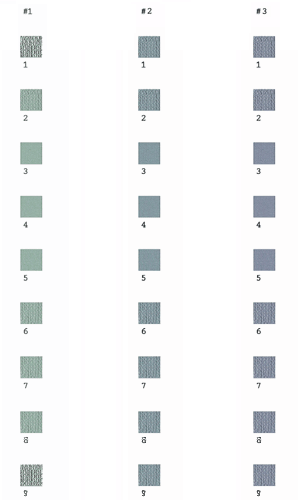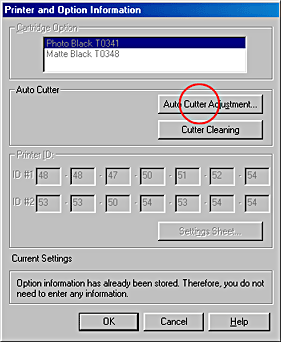![]()
Reference Guide
| Index | Search | Glossary | ||||||||
| Contents | Help |
|
||||||||
|
|
|
|||||||||||||||||||||||||||||||||
Printing with Windows
EPSON Status Monitor 3
Nozzle Check
Head Cleaning
Print Head Alignment
Printer and option information
Speed & Progress
EPSON printer utilities allow you to check the current printer status and to perform some printer maintenance from your computer.
To use the utilities, click the Utility tab in the printer software, then click the button for the utility that you want to use. For information on how to access the printer software, see Accessing the printer software.

 | Note: |
|
|
|
Refer to the appropriate section below.
EPSON Status Monitor 3 provides you with printer status information, such as the amount of ink remaining, and checks for printer errors.
This utility is only available when both of the following conditions are met:
The Nozzle Check utility checks the print head nozzles for clogging. Check the nozzles if you notice print quality has declined and after cleaning to confirm that the print head nozzles have been cleared. If the nozzle check indicates the print head needs cleaning, you can access the Head Cleaning utility directly from the Nozzle Check utility. For details, see Checking the Print Head Nozzles.
The Head Cleaning utility cleans the print head. You may need to clean the print head if you notice print quality has declined. Use the Nozzle Check utility first to confirm that the print head needs to be cleaned. You can access the Nozzle Check utility directly from the Head Cleaning utility. For details, see Cleaning the Print Head.
The Print Head Alignment utility can be used to improve the print quality of your documents. The alignment of the print head may need to be adjusted if vertical lines should appear out of alignment or if white or black banding noise should appear in your documents. Use this utility to realign the print head.
Through this utility the printer will output some different types of test patterns that are used to check the print head alignment. Make sure that A4 or Letter size plain paper is loaded in the sheet feeder to print the first and second test patterns. Also prepare the A4 or Letter size Archival Matte Paper for the third test patterns.
The following images are examples of the first test patterns that will be output by the printer.

From each pattern on the printed test sheet, choose the vertical line that is aligned best. For each pattern, select the corresponding line number from the appropriate drop-down list box in the Print Head Alignment dialog box, then click Finish to put the new settings into effect.
 | Note: |
| If you cannot find a line which is aligned correctly, select the number of the line which is the closest to being correct and click Realignment. The lines you selected will be reset to the center (number 8) position and the alignment test sheet will be printed again. |

The following images are examples of the second test patterns that will be output by the printer.

Look for a pattern that does not contain any black or white banding. Next, find the corresponding pattern number from the drop-down list box in the Print Head Alignment dialog box. Click Finish to enable the adjustment.
 | Note: |
| If all of the patterns contain banding, select the pattern with the least amount of banding and click Realignment. The selected pattern will be shifted to the center position and a new alignment sheet will be printed. |

The following images are examples of the third test patterns that will be output by the printer.

From each pattern on the printed test sheet, choose the least grainy one. For each pattern, select the corresponding pattern number from the appropriate drop-down list box in the Print Head Alignment box, then click Finish to put the new settings into effect.
 | Note: |
| If you cannot find a smooth pattern, select the number for the pattern that is the least grainy and click Realignment. The gap adjustment sheet will be printed again. If you can select a smooth pattern and do not need to print the test pattern again, clear check boxes #1 ~ #3 on the right. |

This utility allows the printer driver to confirm printer configuration information. It also provides specific information regarding certain characteristics of the printer, such as the Printer ID.
The printer driver usually gets the ink cartridge information automatically, and print with the appropriate print mode. However, if the printer driver does not show the amount of the remaining ink in the Main Menu, you need to set the right ink cartridge information yourself. Select the correct ink cartridge from the list of the cartridge option.
 | Note: |
| After replacing the ink cartridge, always confirm that the correct information is selected. |

After you attach the cutter, make sure to adjust the cutting position to improve its precision.
 | Note: |
|
|
 | Click the Auto Cutter Adjustment button. The Auto Cutter Adjustment dialog box opens. |

 | After making sure that the roll paper is set, click the Print button. The cutting position adjustment pattern is printed and cut off. |

 | By using the cut roll paper, check the most precisely printed number among the color boundaries. |

 | Select the number that corresponds to the most precise cut between the two-color squares. Click Finish to enable the adjustment. |

The Cutter Cleaning utility cleans the cutter blade. You may need to clean the automatic roll paper cutter, if you notice that the end face of a page that was cut is stained. Use this utility to clean the cutter.
 | Note: |
| Set the roll paper to use this utility. Refer to Loading the roll paper for more details about the roll paper setting. |
The utility consumes about 7 cm of roll paper for cleaning.
 | Click the Cutter Cleaning button. The Cutter Cleaning dialog box appears. |

 | Click the Clean button. The printer feeds the roll paper and cut it. |

Depending on the configuration of your system, the information displayed in the Printer and Option Information dialog box may be updated automatically, or may need to be entered manually.
If a message appears in the Current Settings window prompting you to enter settings, or if you change the printer configuration, follow the steps below to make the necessary settings manually.
 | Click the Settings Sheet button in the Printer and Option Information dialog box to print out information about your printer and options. A4 or Letter size paper must be loaded in your printer to use this utility. You will see a printout similar to the one below. |

 | Make sure the settings in the utility match the information on the printed Settings Sheet. If they do not match, correct the settings on the screen to match the information on the settings sheet. |
 | Click OK to exit this menu and save your settings. |
You can make settings related to print speed and progress in this dialog box.

The available settings are listed below.
 | Note: |
| The specific features available in the printer software vary depending on the printer model and the version of Windows that you are using. |
To print multiple copies of your document faster, select High Speed Copies. This speeds up printing by using your hard disk space as a cache when printing multiple copies of your document.
To display the Progress Meter every time you print, select Show Progress Meter.
For printer models that use the parallel port, you can speed up the data transfer rate by selecting EPSON Printer Port.
Parallel port users can further increase print speed by enabling DMA transfer, as explained in Enabling DMA transfer.
Select this check box to have Windows NT-based clients spool documents using the RAW format instead of the EMF (metafile) format (Windows NT-based applications use the EMF format by default).
Try using this option if documents spooled in EMF format do not print correctly.
Spooling RAW datatype requires less resources than EMF, so some problems ("Insufficient memory/disk space to print", "Slow print speed", etc.) can be solved by selecting the Always spool RAW datatype check box.
 | Note: |
| When spooling RAW datatype, print progress as displayed by the Progress Meter may differ from actual print progress. |
Click this button to open the Monitoring Preferences dialog box, where you can make settings for EPSON Status Monitor 3.

You can make the following settings:
|
Select Notification |
Displays the current error notification settings. Select the check boxes of the error types for which you want to receive notification. Also select the Alert check box if you want to be notified of error messages with an audio alert.
Note: |
|
Allow monitoring of shared printers |
Select this check box to allow monitoring of a shared printer by other computers. |
 Previous |
 Next |
| Version 1.00E, Copyright © 2001, SEIKO EPSON CORPORATION |